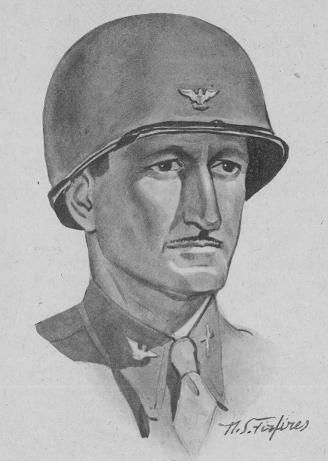 ¹
¹
 ¹
¹
Robert Trueheart Foster
Commanding Officer 22nd Infantry
4th Infantry Division
June 11, 1944 - July 8, 1944
Robert T. Foster was born in Louisiana on March 13, 1897.
He entered the US Military
Academy on June 15, 1915 and under a wartime accelerated program
graduated on June 12, 1918, being commissioned a 2nd Lieutenant
of Infantry. He was ranked number
130 out of a class of 137. His best subjects were Drill
Regulations, Ordnance and French and his worst
subjects were Law and Civil and Military Engineering. During his
graduating year he was a Lieutenant
in the Corps of Cadets in Company H.
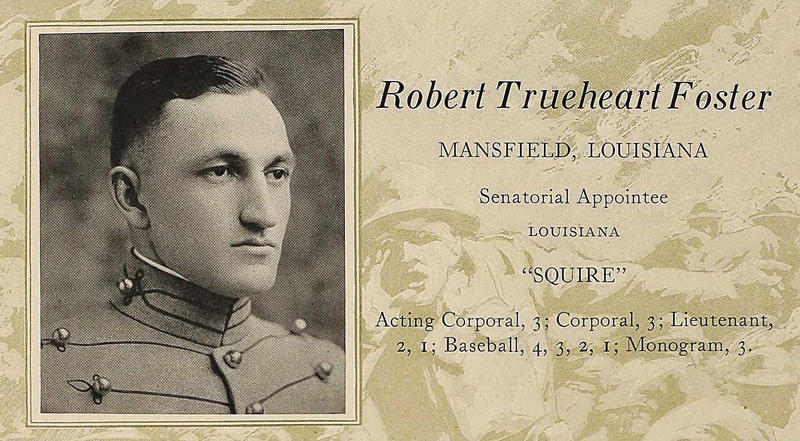
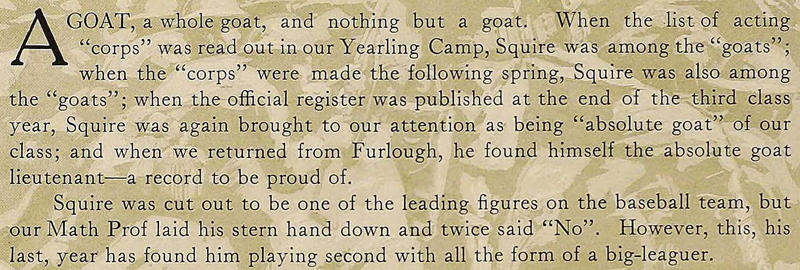
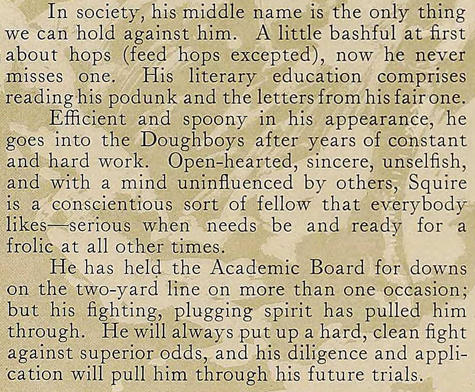
Above: The entry for Robert T. Foster in the 1919 yearbook of the U.S. Military Academy the Howitzer
|
Left: Foster at the U.S.
Military Academy wearing Foster was a valuable player on
the Army Baseball Photo from the 1919 Howtizer yearbook
|
Upon graduation Foster was
assigned to the 46th Infantry, and served with the regiment at
Camp Sheridan, Alabama, from August 28 to December 13, 1918, then
at Camp Bragg, North Carolina,
until March 13, 1919, then at Charleston, South Carolina until
May 5, 1919. He then reported to the
3rd Overseas Replacement Battalion at Camp Meade, Maryland, and
left for Germany on May 19, 1919.
He served in the 4th Infantry in Plaidt, Germany from June 14 to
August 7, 1919, and on that date joined
Headquarters Troop at Coblenz, Germany.
He was promoted to 1st Lieutenant on October 20, 1919.
On December 31, 1920 he was
assigned to the 8th Infantry. In January 1923 he was at Fort
Screven, Georgia
on duty with the 8th Infantry.
At some time after January 1923 Foster was assigned to the 22nd Infantry.
(At this point Cullum's Register is vague about Foster's assignments. It records the following:
"...
at Fort Screven, Ga., Camp McClellan, Ala., and Fort McPherson,
Ga., with 8th Infantry
and 22nd Infantry, Jan., 1923, to Sept. 16, 1928.")
On September 16, 1928 Foster
reported to the Infantry School at Fort Benning, Georgia as a
student officer
in the Company Officers' Course, graduating with his class on
June 11, 1929.
On September 9, 1929 he was at
Fort Monmouth, New Jersey as a student officer at the Signal
School.
He graduated from the Signal School Communication Officers Course
on June 6, 1930.
On June 6, 1930 Foster became
one of the instructors at the Infantry School at Fort Benning,
Georgia
as part of the Second Section teaching signal communications.
|
Standing in background is Photo taken at the Infantry
School At this time Foster was
officially Foster would serve as a junior
officer Photo from: |
While he was an instructor at the Infantry School Foster was promoted to Captain on October 1, 1933.
He left the Infantry School on
June 17, 1934 and reported to Fort Sam Houston, Texas where he
commanded
a Company and became the Regimental S-4 of the 9th Infantry. He
remained in those positions until September 1, 1939.
He attended the Command &
General Staff School at Fort Leavenworth, Kansas as a student
officer on September 5, 1939,
graduating from the course on February 1, 1940. He reported to
Fort Benning, Georgia on February 6 where he became the
Regimental S-4 of the 26th Infantry. He went with the Regiment
when it changed station to Plattsburg, New York.
Foster was promoted to Major on April 30, 1940.
He left the 26th Infantry in April 1941 and became an instructor of Logistics at Fort Benning, Georgia.
On June 12, 1941 he was offered
the temporary rank of Lieutenant Colonel (AUS), which he accepted
on June 14 of that year. On August 26, 1942 he was promoted to
the temporary rank of Colonel (AUS).
He received his permanent rank of Lieutenant Colonel in the
Regular Army on September 2, 1942.
In July 1943 he left Fort
Benning and became the Commanding Officer of the 260th Infantry
at Camp Shelby,
Mississippi as it was being activated as part of the 65th
Infantry Division. He left that assignment and arrived
in the European Theater of Operations in May 1944.
On June 11, 1944 he assumed
command of the 22nd Infantry, replacing Colonel Hervey Tribolet,
who had been relieved for not taking his planned objectives. Like
Tribolet, Foster faced stiff and
unexpected German resistance, and, like Tribloet, Foster also
failed to gain his ordered objectives.
Accordingly, he also was relieved of his command, and replaced on
July 9 by Colonel Charles T. Lanham.
Foster was transferred to the
83rd Division, where he was temporarily placed in command of the
331st Infantry Regiment, on July 11, 1944. Two days later, on
July 13, 1944 he became the Commander
of the 330th Infantry Regiment, engaged in the area around
Carentan. Ironically, Foster was replacing
a Regimental Commander, Colonel Ernest L. McLendon, who had also
been relieved of his command.
He commanded the 330th Infantry
through its service in France, Belgium, Luxembourg, Holland
and Germany during the war.
With this regiment, Foster was
quite successful in his command. The 330th Infantry took part in
the breakout
from Normandy, and on December 3, 1944, relieved the 22nd
Infantry in the battles of the Hürtgen Forest,
taking over the sector the 22nd Infantry had occupied. In
December of 1944 Foster was wounded.
On December 22, 1944 he resumed command of the 330th Infantry,
and led them through the rest of the war,
taking part in the link-up with Russian forces at the Elbe River
in 1945. He commanded the Regiment on
occupation duty in Germany.
He relinquished command of the
330th Infantry in February 1946 and went to Vienna, Austria on
temporary duty
at Headquarters U.S. Army Forces Austria from March to May 1946.
He was promoted to Colonel in the Regular Army on March 11, 1948.
On April 30, 1951 Colonel Robert T. Foster retired from the Army.

Robert T. Foster's decorations
Robert Trueheart Foster
NO. 6025 CLASS OF JUNE 1918
Died 5 October 1986 in Anniston, Alabama, aged 89 years.
Interment: Forest Lawn, Anniston Alabama
" SQUIRE" FOSTER was
born on 13 March 1897 in Mansfield, Louisiana. His father, Edwin
K. Foster, died
when he was five years old. His mother, Isabella Gibbs Foster,
died when he was twelve. Thereafter he was raised
by his cousin, Helen Gibbs, and by his maternal grandmother who
was a native of Virginia. Her husband,
Dr. Robert Trueheart Gibbs, also a native Virginian, was an Army
surgeon during the Mexican War and was also
in the Confederate Army.
Squire graduated from Mansfield
High School. He then attended the Army-Navy
Preparatory School, Washington, DC for a year to fulfill his
long-time desire to go to West Point.
Also attending were his future classmates Barragan, Clay,
Hazelhurst, Tye, and Ward, C.S.
He entered the Academy on 15
June 1915. By 1 July, Beast Barracks had ended and "Beast
Camp" had started.
It was an experience that required determination to endure and
survive. Squire Foster survived. His rich, Southern accent
probably attracted the extra unwanted attention of the
upperclassmen from outside the South. Squire was a lieutenant
in H Company. He turned out for baseball, earning his
"A."
Quotes from his class Howitzer:
"Openhearted, sincere,
unselfish, conscientious, serious when he needed to be, ready for
a frolic at all other times.
Fighting, plugging spirit. He will always put up a hard, clean
fight against superior odds, and his diligence and application
will pull him through his future trials." Those words were a
true measure of a future combat infantryman, the commander
of an infantry regiment that fought valiantly and with glory from
Normandy and Brittany to the east bank of the Elbe River.
Upon early graduation because of
World War I, the Class of 1919 became the Class of June 1918. The
Class crest,
with 1919, was retained.
Squire was assigned to the 46th
Infantry Regiment, 9th Infantry Division, upon graduation. After
a 30-day leave, he was
ordered to the Infantry School of Arms, Fort Sill, for a special
ten-week course in infantry weapons and small unit tactics.
He served during 1919-23 with the 4th Infantry, 3rd Division;
Headquarters, Allied Forces Germany; and the 8th Infantry
in Germany in the Coblenz area. On his return to the States with
the 8th Infantry, he served at Fort Screven, Georgia;
Camp McClellan, Anniston, Alabama; and at Fort McPherson, Georgia
to 1928.
It was while he was at Camp McClellan that he married Miss Julia Jones of Anniston on 23 January 1924.
Squire took the Company
Officers' Course at the Infantry School, 1928 to 1929. This was
followed by a nine-month course
at the Signal School. Next, he was assigned to the Infantry
School and served as a member of the 2nd Section from 1930 to
1934.
The first day of October 1933, after fifteen long years as a
lieutenant, Squire was promoted to captain.
He was with the 9th Infantry,
2nd Infantry Division at Fort Sam Houston from 1934-39. In 1939
he started the regular course
at the Command and General Staff School. He was graduated early,
in February 1940, as the country started preparing for war.
He was promoted to major on 30
April 1940 while supply officer, 26th Infantry, 1st Infantry
Division at Plattsburgh Barracks.
In early 1941 the division was concentrated at Fort Devens. From
there he went to the Infantry School in May 1941 to be
an instructor in logistics until May 1943. His temporary
promotion to lieutenant colonel was on 21 June 1941; to colonel,
on 26 August 1942. His next assignment was command of the newly
organized 260th Infantry Regiment, 65th Infantry Division,
at Camp Shelby, May 1943 to May 1944.
He joined the 4th Infantry
Division in England, shortly before the cross-channel invasion.
He moved 2000 replacements
to France on 9 June, three days after D-Day. A few days later, he
was placed in command of the 22nd Infantry Regiment,
4th Infantry Division. He was then 47 years old, old for an
infantry regimental commander in active combat. The regiment
took an active part in the capture of the Cherbourg Peninsula.
Squire was lightly wounded by shell fragments in action
on 24 June. The division commander commended Squire for his fine
performance in the operation, his first under enemy fire.
Shortly after Squire left the
4th Infantry he was immediately given command of the 330th
Infantry Regiment, 83rd Division.
During August his regiment captured the small channel port of St.
Malo in Brittany. The 2nd Battalion was awarded the
Divisional Unit Citation for its capture of the St. Joseph
Fortress after two days of heavy fighting on the 7th and 8th of
August 1944. The battalion killed 250 Germans and 600 prisoners
were taken. The battalion cleared the way for the attack
on St. Malo. His 3rd Battalion, with a battery of field artillery
attached, helped capture the important port of Brest.
On 2 December the division moved
north to the Hurtgen Forest in Germany, about 20 miles southeast
of Aachen.
The 330th was engaged with the enemy very quickly. The 3rd
Battalion was awarded the Divisional Unit Citation
for its capture of the town of Strass on 10 December, permitting
the 5th Armored Division a debouchment from
Hurtgen Forest. Squire was wounded by shell fragments on 12
December and evacuated to a field hospital near Aachen,
but after twelve days returned to his regiment. The final
objective, securing the west bank of the Roer River, was taken
on 26 December. Then the Battle of the Bulge (the Ardennes
Campaign) started. Late in the afternoon of 26 December,
the 330th moved by truck to an assembly area about 25 miles
southwest of Liege, Belgium.
Operating with the 3rd Armored
Division, the 330th drove southward to cut the German salient at
Houfallize, where the
Third Army troops from the south were met on 15 January 1945.
That set the stage for the final elimination of the Bulge.
The 1st Battalion received the Divisional Citation for its
outstanding performance in the capture of Bihain, Belgium on
9-11 January. The enemy had over 500 casualties.
From 15 January to late
February, the 330th spent the time resting, training, and
assimilating replacements.
Then the 83rd moved to support the crossing of the Roer River.
The 330th was attached to the 29th Infantry Division
and crossed the Roer River on 23 February and moved toward the
Rhine. The division cleared up the west bank and then
moved to Belgium and the Netherlands to train for crossing the
Rhine. Late in March, the division again moved into Germany
and on 30 March the 330th and the rest of the division crossed
the river over a pontoon bridge near Wesel, about 30 miles
down from Dusseldorf. A bridgehead had been secured by the 17th
Airborne Division, commanded by his classmate
Bud Miley, who had landed by parachute with his men.
From then on it was a race to
the Elbe, 250 miles to the east. The 330th protected the right
flank of the XIX Corps
and cleared the northern part of the mountains. The regiment
completed its mission in 10 days. It took 2500 prisoners.
It then rejoined the division and occupied a sector on the east
bank of the Elbe near Zerbst, about 20 miles south
of Magdeburg. A German regiment of 900 men surrendered to the
330th, adding to the thousands taken after Normandy.
The 83rd Infantry Division had fully earned its new
nickname—The Thunderbolt Division. The glorious history
of the 330th Infantry in combat is also the glorious history of
Robert Trueheart Foster in combat.
For the 330th after VE-Day came
occupation and civil government, ousting Nazi officals, finding
war criminals,
collecting and destroying military material, closing and guarding
war plants, clearing roads of rubble,
and not by far the least, the care and repatriation of thousands
of displaced persons.
The division was not returned to
the States as a unit. After a leave in the States, Squire was
assigned to duty in Vienna.
It was a very sad parting for the commander and his men. He
returned to the States in May 1946.
Squire was awarded the following
medals: Silver Star Medal for gallantry in action and disregard
for personal safety,
awarded by the Commanding General, 83rd Infantry Division, on 29
December 1944; Bronze Star Medal with V and
two Oak Leaf Clusters; Purple Heart Medal with Oak Leaf Cluster;
and the Combat Infantryman Badge. He also had
the Legion of Merit with Oak Leaf Cluster and the Army
Commendation Medal; also the French Legion d'Honneur
and the Croix de Guerre. He had five campaign bars on his ETO
medal ribbon and commendations during combat
operations from commanders of the 4th Infantry Division, the 83rd
Infantry Division (2) and tin; VII Corps.
Squire served as professor of
Military Science and Tattics at Quachita College, Arkadelphia,
Arkansas from August 1946
to July 1950. He was then ordered to the Far East Command just
before the war in Korea started. He was in command
of the staging and supply area at Camp Kokurj, Japan until he
retired alter 36 years of military service.
After his retirement, Squire and
Julia lived in Asheville, North Carolina until they moved to
Anniston, Alabama,
Julia's hometown, in 1970.
Julia died on 16 April 1981, ending a happy marriage of 57 years. They had no children.
Squire's gravestone should have the highly deserved inscription COMBAT INFANTRYMAN, WW II
£.W.C. ²
Burial:
Forestlawn Gardens and Mausoleum
Anniston
Calhoun County
Alabama
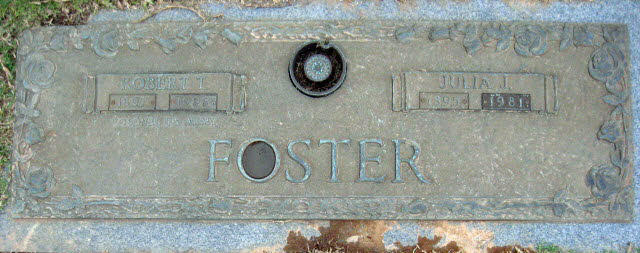
Grave marker for Robert T. Foster and his wife Julia
Photo by Fred Cook from the Find A Grave website
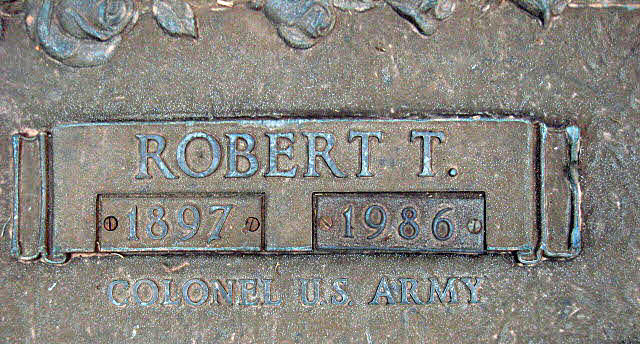
Grave marker for Robert T. Foster and his wife Julia
Photo by Fred Cook from the Find A Grave website
¹ The Story of the 330th Infantry Across Europe ( booklet published by the 83rd Division at the end of WW2 )
² Assembly Magazine, December 1987 Volume XLVI, No. 3
Home | Photos | Battles & History | Current |
Rosters & Reports | Medal of Honor | Killed
in Action |
Personnel Locator | Commanders | Station
List | Campaigns |
Honors | Insignia & Memorabilia | 4-42
Artillery | Taps |
What's New | Editorial | Links |